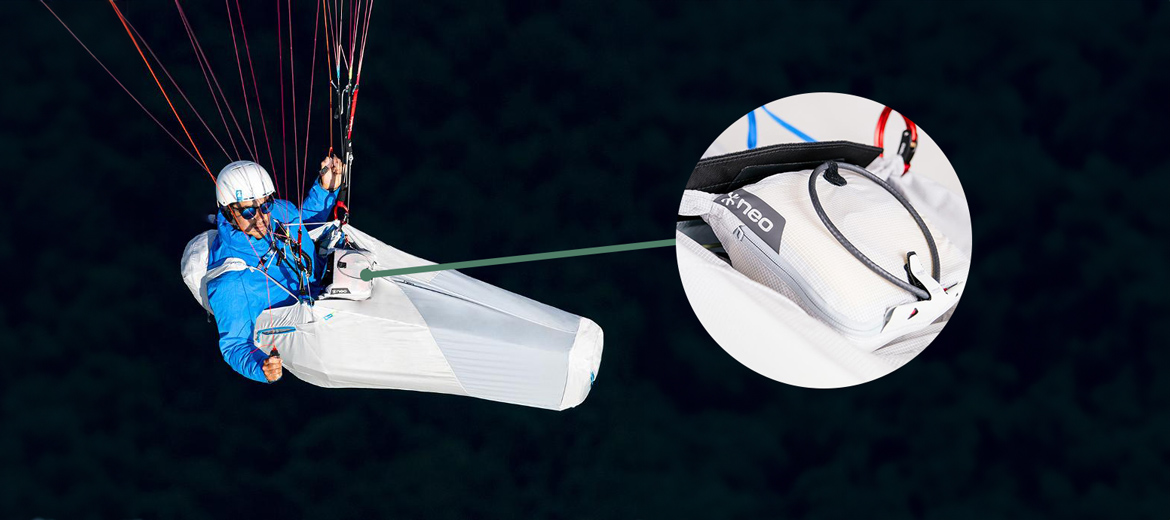How to choose your Paragliding Front Container ?


When venturing into the exciting world of free flight, paragliding and paramotoring, safety is a top priority. Among the key elements that ensure a safe flying experience for the pilot, the rescue parachute occupies a central place. However, the question remains : which front container is best suited to house your rescue parachute ? In this comprehensive guide, we tackle this crucial question by examining the different aspects of rescue parachutes and paragliding.
WHAT TYPE OF RESCUE PARACHUTE IS SUITABLE FOR FRONT CONTAINER ?
A priori, there is no rescue parachute specifically designed for use in a front container, or in a subcutaneous pocket of a harness or similar. However, as long as the rescue parachute is properly packed and connected to the harness, there are no contraindications to using a rescue parachute in a front container.
HOW TO CHOOSE THE RIGHT FRONT CONTAINER FOR YOUR RESCUE PARACHUTE
Before choosing the ideal pocket for your paragliding rescue parachute, it's essential to understand the compatibility between different parachutes and front container.
Choosing a front container based on the volume of your rescue parachute
Probably the most important factor is the packed volume of your rescue parachute.
Indeed, depending on their type (square, round, light etc...), rescue parachutes will occupy a certain volume when packed. You therefore need to choose a front container that is neither too large (otherwise the reserve will float inside) nor too small (otherwise it will be impossible to close the front container).
CHOOSING A FRONT CONTAINER WITH OR WITHOUT RESCUE PARACHUTE RISERS
Once the question of volume has been resolved, it's time to think about the rescue risers you'll need to connect your rescue parachute to the harness.
There are two possibilities :
-
Choosing a rescue bag without risers : Either you already have some at home and will adapt them to your setup, or you want to buy specific risers. Either way, you'll need to purchase risers before you take off, otherwise you won't be able to connect your rescue parachute to the harness.
- Choose a rescue bag with risers: In this case, you don't have to buy risers next to your rescue bag since these are supplied with the bag..
In all cases, make sure you have a rescue riser, and possibly a quick link to connect the rescue parachute to the risers.
Also, consider where you are going to connect your rescue parachute to the harness. If you attach it to the main carabiners, you'll never have any problems. If you choose to attach the rescue risers to the shoulders, then make sure you can attach your risers using the lark's head method, or provide 2 extra quick links.
In conclusion, the choice of front container for your paragliding rescue parachute is of crucial importance to ensure the proper functioning of the system. By taking into account details such as compatibility with your parachute, pouch size, opening mechanism, positioning and practical features such as risers, you'll be able to make a coherent choice. Always bear in mind that safety must be the top priority, and investing in a quality front container to match your rescue parachute is an investment in confident paragliding. Be ready to take on the skies with equipment that combines safety and reliability.
DISCOVER OUR COMPLETE GUIDE TO PARAGLIDING RESCUE PARACHUTES :
Paragliding rescue parachutes : choosing the right equipment for your flight
What types of rescue parachute are there for paragliding ?
Is a rescue parachute compulsory for paragliding ?
How to choose a paragliding rescue parachute ?
How does a rescue parachute work ?
What's the best rescue parachute ?
How much does a rescue parachute cost ?
The difference between a rescue parachute and a front rescue container








